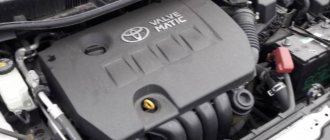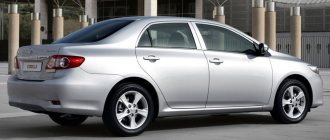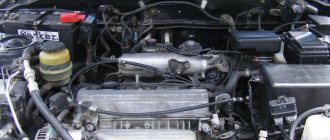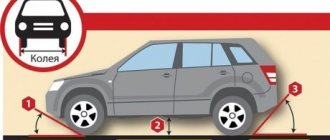Toyota Prius is known to the world community as one of the first car models with a hybrid power plant. The car gained wide popularity primarily due to its fuel consumption, which was less than 4 liters, which, of course, became possible thanks to the use of electric traction. A car with a hybrid installation has won many competitions. It is not for nothing that the word “prius” is translated from Latin as first.
The car began production in 1997, but was sold for 3 years exclusively in Japan. It officially began to be supplied to the countries of North America and Europe only in 2000. The car gained widespread popularity almost instantly because it became a breakthrough idea. Moreover, it was liked not only for its economical fuel consumption indicators, but also due to its attractive and stylish appearance.
Like many other car models, the Toyota Prius was produced in several modifications, including undergoing a lot of modifications. The first of them occurred just in 2000, just before entering the European market and America. Its driving characteristics, appearance and interior have been changed somewhat.
The original Japanese sedan was mainly equipped with a 1.5 liter gasoline engine and a 30 kW electric motor. The second generation of the car went on sale in 2003. The 5-door hatchback quickly attracted the attention of the public because it became even more powerful and reliable. The start of sales of third-generation cars began in 2009. Since that time, a 1.8 liter engine began to be installed on the car.
The year 2007 was marked by the release of the new Prius PHV. It officially went on sale only in 2012. Now the car could only drive on electric power for up to 25 km and required recharging.
Since 2011, an equally attractive station wagon began to be produced. The wheelbase has been increased. In the same year, the shortened Prius S was released. It had the lowest fuel consumption. In 2015, sales of the 4th generation Toyota Prius started. The appearance was changed, which became futuristic. The transmission and hybrid installation have also been changed, becoming much more compact and at the same time more powerful. In 2021, the updated Prius Prime model was released. Now it charges in just 20 minutes, and the electric range is 68 km.
For all years of production, from 1997 to the present, the following types of power units have been installed on Japanese cars:
| Generation | Brand | Volume, l | Type of fuel | Power, hp |
| I, II | 1NZ-FXE | 1.5 | petrol | 76 |
| III, IV | 2ZR-FXE | 1.8 | petrol | 98 |
What is a hybrid car
In general, a hybrid car is a car that uses more than one energy source to drive its wheels. Moreover, the second source may not necessarily be an electric motor. But since we are talking about the Toyota Prius, the second source will be the electric drive.
The Prius is equipped with a conventional internal combustion engine (ICE) of low power and in addition an electric motor with a battery. As long as the internal combustion engine has enough energy to move, the electric drive is disabled. As soon as the gasoline engine lacks strength (acceleration, climbing, etc.), an electric motor comes to its aid. The on-board computer decides whether to help the internal combustion engine or not. No driver participation is required here.
The electric drive battery is charged from a special generator, but not constantly (otherwise there would be no gain in using the electric drive), but only when the internal combustion engine has nothing or almost nothing to do. For example, when driving slowly, coasting, on descents or when idling. Thus, the battery stores energy that would otherwise be wasted.
Therefore, a hybrid car is not at all “whatever I want, I’ll drive it,” and certainly not an electric car. It runs on gasoline, and the electric motor is an assistant.
Toyota Prius hybrid car
[Translation] Toyota wanted to charge me $4400 to replace the battery. I fixed it myself for $10
This is a translation of a post from Reddit, which I found informative and proving that many things, even those that seem complicated at first glance, can be fixed on your own.
WARNING: This text describes repairs to the high voltage battery system. Follow safety precautions! Careless intervention can be fatal!
I worked as an electrician with my father (he's an expert in this field) when I was younger, so I have an idea of what I'm doing. Once again I warn you about safety precautions!
Now, actually, the story...
This happened last Saturday on the way home (see title picture). All the warnings on the panel came on at once. When I got home, I googled and found out that in Camry models this could be caused by a faulty brake actuator. In this case, the manufacturer eliminated the malfunction with an extended warranty. It could be assumed that the “Check Hybrid System” malfunction signal came on by mistake and I would get off easy, because... this mistake could lead to costly repairs! I was very worried because... I bought the car second-hand, without a warranty, just a couple of weeks ago (I haven’t even received the license plate yet).
I went to the service center in the morning and after 4 hours of diagnostics they informed me that my battery was dead and needed to be replaced. The issue price is $4400.
But I just bought this car! 4000 bucks?! This is more than half the price for which I bought it! I contacted customer service and after a couple of days they offered me only a $500 refund of the cost. My breakdown was covered under warranty, but my mileage was exceeded. It became sad.
Then I remembered something I read somewhere when I bought my first Prius about repairing the battery system by replacing a single bad battery. And I'm willing to bet that this Camry had the same (or similar) battery systems. There's only one way to find out...
I pulled out the battery system and brought it into the garage. It looked the same as the Prius. This got me thinking: they are interchangeable! I decided to discover those cells that may be producing less voltage than expected. The thing is that it is possible to replace one faulty cell for only $45. It will be easy.
Started testing.
I removed the busbar (these orange things - they contain copper connectors that connect all the batteries into a common system) and began testing the batteries separately:
8.11v, 8.10v, 8.10v, 8.11v...all seemed fine.
These small lamps were not enough for testing, so I used a spool of winding wire.
I noticed that there is rust on the connectors. It shouldn't be this way.
I tested each cell three times and the voltage was always within acceptable values. I waited a couple of hours and repeated the test. And everything is fine again. Strange.
I attached a coil (to add resistance) and tested again. And again the batteries turned out to be normal. That is, all the batteries were intact, without malfunctions. This meant that replacing the batteries, which was offered at the service center, would be a waste of money.
But what about rust? Could rust on a few connectors be causing insufficient power to the entire system? I decided to clear them all.
First, I soaked all 34 connectors in a vinegar solution, then gently sanded them with a steel wool sponge and rinsed them with a solution of baking soda and distilled water to get rid of any remaining vinegar. In the top picture I am holding an already cleaned connector and an uncleaned one. I did the same with the bus wire to which the connectors are attached. It took me about an hour to do everything. Rinse and reassemble.
Repair for $10
I quickly put the battery system back together and installed it in the car.
All errors are gone!
All this time I was driving on gasoline, and the electric system was not functioning. Now charging and discharging occurred correctly. And all thanks to cleaning the connectors.
My golf cart is back in action!
Battery design and specifications
Structurally, the Toyota Prius battery is a unit assembled from 28 cells with nickel-metal hydride batteries with a voltage of 7.2 V and a capacity of 6.5 Ah.
Thus, a complete block (VVB) has a capacity of 1.3 kWh. The figure is amazing, isn't it? The battery capacity of the Nissan Leaf electric car is 30 kWh, and Tesla's is even larger. But we found out in the previous section that the electric motor in the Prius is not the main drive. It simply helps the internal combustion engine at the right moment, and recharges the rest of the time. So this capacity will be more than enough.
Expert opinion
Alexey Bartosh
Specialist in repair and maintenance of electrical equipment and industrial electronics.
Ask a Question
Interesting. The actual capacity of Toyota Prius batteries is much lower, since the on-board computer does not charge it above 65% and does not discharge it below 40%. This solution made it possible to increase the number of charge/discharge cycles to 50,000, and the service life to 10–15 years. In addition, NiMH batteries can be charged up to 70% with high currents - this speeds up their energy accumulation.
In Toyota Prius NHW10 models, the cells look like thin cylinders, which owners of hybrid cars called bamboos.
Budget batteries for Toyota Prius
Don’t know where to buy a cheaper battery for a Toyota Prius? Contact the services of our company. Here you will find several options for completely reliable batteries that will cope with their task and ensure a stable start throughout their 4-5 years of operation.
| Manufacturer (country) | Brand | Capacity, Ah | Starting current at -18 | Guarantee | Cost, rub. |
| Tyumen (Russia) | Asia 50 R+ | 50 | 410 | 2 | 2400 |
| VARTA (Czech Republic) | Blue Dynamic B31 | 45 | 330 | 1 year | 2600 |
| Smart ELEMENT (Russia) | Asia 6CT-50.0 60B24L | 50 | 470 | 6 months | 3400 |
Everyone knows that the manufacturer used a small battery on the Toyota Prius, but with such dimensions you can get more power. One such example will be the Russian battery from Smart ELEMENT. It has a larger capacity, which means more traction power and an increased starting current of 140 A compared to the standard battery. This indicates stable engine starting in winter. With such a battery, you will forget about charging problems for a long time, but the quality of this battery is still somewhat worse than its analogues.
Purchasing such a source is relevant if the car is going to be sold, but it depends on how you look. If you compare the service life of two budget batteries and the Japanese YUASA, then it is more profitable to buy just 2 cheap ones.
There are 2 prices shown on the website. But you can order a smaller battery if you give us your old one as credit. In addition, we also offer services for replacing batteries and diagnosing charging circuits, since the warranty only applies if all electrical components are in good working order. If problems are found, we will recommend experienced technicians to you.
If you have not yet chosen a battery, we are happy to help you. If necessary, we will organize prompt delivery to any city in the Russian Federation, for which you will not have to pay. If you have any questions, ask our expert by phone or chat on the website.
Do I need to charge it and how to do it correctly?
We are all accustomed to the fact that the battery of a regular car, if necessary or for preventative purposes, can be removed and charged with a stationary charger. Is it necessary to do the same with the Toyota Prius battery? Theoretically, the Prius VBB is a regular NiMH battery, and charging it will not be a problem. But in practice it is not so simple. Firstly, few people have a charger with an output voltage of 250 V, or rather, no one has it. Secondly, you need to have a good understanding of how to properly charge a nickel-metal hydride battery. During charging, the on-board computer controls and makes certain decisions on the following parameters:
- by absolute temperature;
- by the rate of temperature change;
- by negative delta;
- by maximum charging time;
- by maximum pressure;
- at maximum voltage.
To take all these factors into account, you need not only knowledge, but also appropriate equipment, which certainly none of us have gathering dust in our garage. And without taking all this into account, we will not only fail to charge the explosive device, but will reliably kill it.
We draw an unambiguous conclusion - the high-voltage battery of a Toyota Prius cannot be charged independently. If the VVB sits down, then we simply start the engine with the starter and rumble at idle or quietly drive to our destination on gasoline. The internal combustion engine will have enough power for this, and the on-board computer will take care of the charge.
In addition, if the high-voltage battery is dead, then this is a sure sign that something is wrong with the car. Even if we take it off and somehow miraculously charge it, it will only be until next time. The problem will not go away. Therefore, we start our Prius with a regular starter and go to the service center. There they will conduct a full diagnostic, and if everything is in order with the car, they will charge the battery according to all the laws of physics.
Healthy. The Prius, like a regular car, has a 12-volt, 45 Ah lead-acid battery that powers the starter motor. Here you can (if necessary) remove and charge it. The battery is located under the trunk floor on the right.
Can the battery be replaced or repaired?
Of course, you can replace the high-voltage battery like any other component, although you will have to tinker. Repair is somewhat more complicated, so let's start with replacing it entirely.
Replacement of VVB
Open the trunk, remove the false floor, disconnect one terminal of the small battery.
Important! Before closing the trunk lid, be sure to connect the small battery. Otherwise, there will be problems opening the lid.
We recline the backs of the rear seats and get to the bolts that secure them. Unscrew the bolts securing the backrests and the bolt securing the middle seat belt. We remove the backrests and sofa.
Unscrew the two screws securing the high-voltage battery cover.
We remove the upholstery, which prevents the cover from being removed from the VVB. Remove the plastic trim from the edge of the trunk. The upholstery and edging are secured with clips.
Remove the trunk side trim.
Along the perimeter of the VVB, we unscrew all the bolts by 12. We remove the “ears” that secure the battery to the body on the sides.
The VVB is attached to the body with 12 bolts
Unscrew and remove the air ducts. We take out the VVB fuse. On the left side of the battery (looking from the trunk) there is a cover covering the control unit (CU). Unscrew the mounting bolts and remove it.
Under the cover we find power cables. We unscrew them.
We disconnect all the power connectors of the control unit and remove the battery.
Expert opinion
Alexey Bartosh
Specialist in repair and maintenance of electrical equipment and industrial electronics.
Ask a Question
Important! The edges of the battery are very sharp, and the battery itself weighs about 30 kilograms. If handled carelessly, this edge can easily cut off your fingers. We remove and carry the VVB only with gloves, extremely carefully.











